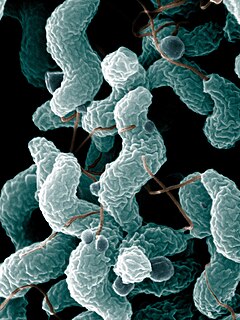
Thermus is a genus of thermophilic bacteria. It is one of several bacteria belonging to the Deinococcota phylum. Thermus species can be distinguished from other genera in the family Thermaceae as well as all other bacteria by the presence of eight conserved signature indels (CSIs) found in proteins such as adenylate kinase and replicative DNA helicase as well as 14 conserved signature proteins (CSPs) that are exclusively shared by members of this genus.
Sulfur-reducing bacteria are microorganisms able to reduce elemental sulfur (S0) to hydrogen sulfide (H2S). These microbes use inorganic sulfur compounds as electron acceptors to sustain several activities such as respiration, conserving energy and growth, in absence of oxygen. The final product or these processes, sulfide, has a considerable influence on the chemistry of the environment and, in addition, is used as electron donor for a large variety of microbial metabolisms. Several types of bacteria and many non-methanogenic archaea can reduce sulfur. Microbial sulfur reduction was already shown in early studies, which highlighted the first proof of S0 reduction in a vibrioid bacterium from mud, with sulfur as electron acceptor and H
2 as electron donor. The first pure cultured species of sulfur-reducing bacteria, Desulfuromonas acetoxidans, was discovered in 1976 and described by Pfennig Norbert and Biebel Hanno as an anaerobic sulfur-reducing and acetate-oxidizing bacterium, not able to reduce sulfate. Only few taxa are true sulfur-reducing bacteria, using sulfur reduction as the only or main catabolic reaction. Normally, they couple this reaction with the oxidation of acetate, succinate or other organic compounds. In general, sulfate-reducing bacteria are able to use both sulfate and elemental sulfur as electron acceptors. Thanks to its abundancy and thermodynamic stability, sulfate is the most studied electron acceptor for anaerobic respiration that involves sulfur compounds. Elemental sulfur, however, is very abundant and important, especially in deep-sea hydrothermal vents, hot springs and other extreme environments, making its isolation more difficult. Some bacteria – such as Proteus, Campylobacter, Pseudomonas and Salmonella – have the ability to reduce sulfur, but can also use oxygen and other terminal electron acceptors.

Campylobacterota are a phylum of bacteria. All species of this phylum are Gram-negative.
Thermoanaerobacter is a genus in the phylum Bacillota (Bacteria). Members of this genus are thermophilic and anaerobic, several of them were previously described as Clostridium species and members of the now obsolete genera Acetogenium and Thermobacteroides
Deferribacter is a genus in the phylum Deferribacterota (Bacteria).
Thermodesulfobacterium hydrogeniphilum is a species of Sulfate-reducing bacteria. It is thermophilic, chemolithoautotrophic, non-spore-forming, marine species, with type strain SL6T.
Caminibacter profundus is a species of moderately thermophilic, microaerobic to anaerobic, chemolithoautotrophic bacterium. It is a Gram-negative, non-motile rod, with type strain CRT.
Laceyella is a Gram-positive, thermophilic, spore-forming and aerobic bacterial genus from the family of Thermoactinomycetaceae. The genus Laceyella is namened after the English microbiologist John Lacey.
Planifilum is a Gram-positive and aerobic bacterial genus from the family of Thermoactinomycetaceae.
Caloranaerobacter is a Gram-negative, thermophilic, anaerobic and chemoorganotrophic bacterial genus from the family of Clostridiaceae.
Garciella is a Gram-positive, halotolerant, obligately anaerobic and moderately thermophilic bacterial genus from the family of Eubacteriaceae with one known species.
Tepidibacter formicigenes is a Gram-positive, spore-forming and anaerobic bacterium from the genus of Tepidibacter which has been isolated from hydrothermal vent fluid from the Mid-Atlantic Ridge.
Caldanaerobius is a moderately thermophilic and anaerobic genus of bacteria from the family of Thermoanaerobacteraceae with one known species.
Pontibacillus is a Gram-positive, spore-forming and strictly aerobic genus of bacteria from the family of Bacillaceae.
Hippea is an obligate anaerobic and moderately thermophilic bacteria genus from the family of Desulfobacteraceae. Hippea is named after the German microbiologist Hans Hippe.
Vulcanibacillus is a genus of bacteria from the family of Bacillaceae with one known species. Vulcanibacillus modesticaldus has been isolated from a hydrothermal vent from the Rainbow Vent Field.
Thermostilla is a thermophilic genus of bacteria from the family of Planctomycetaceae with one known species. Thermostilla marina has been isolated from a hydrothermal vent from a Vulcano Island in Italy.
Deferrisoma camini is a moderately thermophilic and anaerobic bacterium from the genus of Deferrisoma which has been isolated from a deep-sea hydrothermal vent from the Eastern Lau Spreading Centre in the Pacific Ocean.
Paramaledivibacter is a strictly anaerobic, slightly halophilic, non-spore-forming and moderately thermophilic genus of bacteria from the family of Clostridiaceae with one known species. Clostridium caminithermale has been reclassified to Paramaledivibacter caminithermalis. Paramaledivibacter caminithermalis has been isolated from a deep-sea hydrothermal vent from the Atlantic Ocean Ridge.
Exiguobacterium profundum is a Gram-positive, halotolerant, facultative anaerobic, moderately thermophilic and non-spore-forming bacterium from the genus of Exiguobacterium which has been isolade from a hydrothermal vent from the East Pacific Rise.

